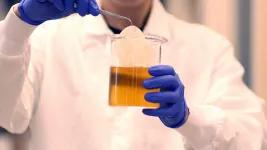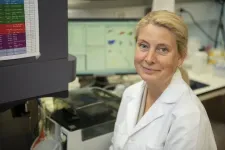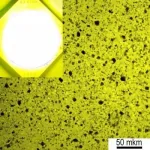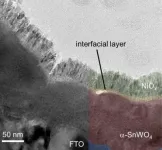(Press-News.org) RESEARCH TRIANGLE PARK, N.C. -- Kombucha tea, a trendy fermented beverage, inspired researchers to develop a new way to generate tough, functional materials using a mixture of bacteria and yeast similar to the kombucha mother used to ferment tea.
With Army funding, using this mixture, also called a SCOBY, or symbiotic culture of bacteria and yeast, engineers at MIT and Imperial College London produced cellulose embedded with enzymes that can perform a variety of functions, such as sensing environmental pollutants and self-healing materials.
The team also showed that they could incorporate yeast directly into the cellulose, creating living materials that could be used to purify water for Soldiers in the field or make smart packaging materials that can detect damage.
"This work provides insights into how synthetic biology approaches can harness the design of biotic-abiotic interfaces with biological organization over multiple length scales," said Dr. Dawanne Poree, program manager, Army Research Office, an element of the U.S. Army Combat Capabilities Development Command, now known as DEVCOM, Army Research Laboratory. "This is important to the Army as this can lead to new materials with potential applications in microbial fuel cells, sense and respond systems, and self-reporting and self-repairing materials."
The research, published in Nature Materials was funded by ARO and the Army's Institute for Soldier Nanotechnologies at the Massachusetts Institute of Technology. The U.S. Army established the ISN in 2002 as an interdisciplinary research center devoted to dramatically improving the protection, survivability, and mission capabilities of the Soldier and Soldier-supporting platforms and systems.
"We foresee a future where diverse materials could be grown at home or in local production facilities, using biology rather than resource-intensive centralized manufacturing," said Timothy Lu, an MIT associate professor of electrical engineering and computer science and of biological engineering.
Researchers produced cellulose embedded with enzymes, creating living materials that could be used to purify water for Soldiers in the field or make smart packaging materials that can detect damage.
These fermentation factories, which usually contain one species of bacteria and one or more yeast species, produce ethanol, cellulose, and acetic acid that gives kombucha tea its distinctive flavor.
Most of the wild yeast strains used for fermentation are difficult to genetically modify, so the researchers replaced them with a strain of laboratory yeast called Saccharomyces cerevisiae. They combined the yeast with a type of bacteria called Komagataeibacter rhaeticus that their collaborators at Imperial College London had previously isolated from a kombucha mother. This species can produce large quantities of cellulose.
Because the researchers used a laboratory strain of yeast, they could engineer the cells to do any of the things that lab yeast can do, such as producing enzymes that glow in the dark, or sensing pollutants or pathogens in the environment. The yeast can also be programmed so that they can break down pollutants/pathogens after detecting them, which is highly relevant to Army for chem/bio defense applications.
"Our community believes that living materials could provide the most effective sensing of chem/bio warfare agents, especially those of unknown genetics and chemistry," said Dr. Jim Burgess ISN program manager for ARO.
The bacteria in the culture produced large-scale quantities of tough cellulose that served as a scaffold. The researchers designed their system so that they can control whether the yeast themselves, or just the enzymes that they produce, are incorporated into the cellulose structure. It takes only a few days to grow the material, and if left long enough, it can thicken to occupy a space as large as a bathtub.
"We think this is a good system that is very cheap and very easy to make in very large quantities," said MIT graduate student and the paper's lead author, Tzu-Chieh Tang.
To demonstrate the potential of their microbe culture, which they call Syn-SCOBY, the researchers created a material incorporating yeast that senses estradiol, which is sometimes found as an environmental pollutant. In another version, they used a strain of yeast that produces a glowing protein called luciferase when exposed to blue light. These yeasts could be swapped out for other strains that detect other pollutants, metals, or pathogens.
The researchers are now looking into using the Syn-SCOBY system for biomedical or food applications. For example, engineering the yeast cells to produce antimicrobials or proteins that could benefit human health.
INFORMATION:
The MIT-MISTI MIT-Imperial College London Seed Fund and the MIT J-WAFS Fellowship also supported this research.
Visit the laboratory's Media Center to discover more Army science and technology stories
DEVCOM Army Research Laboratory is an element of the U.S. Army Combat Capabilities Development Command. As the Army's corporate research laboratory, ARL is operationalizing science to achieve transformational overmatch. Through collaboration across the command's core technical competencies, DEVCOM leads in the discovery, development and delivery of the technology-based capabilities required to make Soldiers more successful at winning the nation's wars and come home safely. DEVCOM is a major subordinate command of the Army Futures Command.
COLUMBIA, Mo. - In 2016, the World Health Organization called the Zika virus epidemic a "public health emergency of international concern" due to the virus causing birth defects for pregnant women in addition to neurological problems. Since then, researchers have wrestled with different strategies for controlling the spread of Zika virus, which gets transmitted to humans from female mosquito bites.
One approach, which was approved by the Environmental Protection Agency in May, will release more than 750 million genetically modified mosquitos into the Florida Keys in 2021 and 2022. These "suicide mosquitos" are genetically-altered to produce offspring that die before emerging into adults and therefore cannot ...
An international research collaboration, involving scientists from the UK, US and Spain, has shed new light on the usefulness of digital contact tracing (DCT) to control the spread of Covid-19.
The study, published today in Nature Communications, assessed the effectiveness of the Spanish DCT app, Radar COVID, following a 4-week experiment conducted in the Canary Islands, Spain between June-July 2020.
For the experiment, funded by the Secretary of State of Digitalisation and Artificial Intelligence (SEDIA), the researchers simulated a series of Covid infections in the capital of La Gomera, San Sebastián de la Gomera, to understand whether the Radar COVID app technology could ...
Individual variations in how the immune system responds to SARS-CoV-2 appear to impact the severity of disease. Researchers at Karolinska Institutet in Sweden have now been able to show that patients with severe COVID-19 have significantly elevated levels of a certain type of immune cells in their blood, called myeloid-derived suppressor cells. The study published in the Journal of Clinical Investigation may bring an increased understanding of how early immune responses impact disease severity.
Most individuals with COVID-19 develop mild to moderate symptoms and recover without needing hospital treatment. In severe cases, however, COVID-19 can lead to respiratory failure or even death. It is not yet known ...
Materials scientists of Far Eastern Federal University (FEFU), in collaboration with an international research team, have advanced the design of composite ceramic materials (Ce3+:YAG-Al2O3), i.e. solid-state light converters (phosphors) that can be applied in-ground and aerospace technologies. The LED systems based on the developed materials to save 20-30 percent more energy compared to commercial analogues. A related article was published in Materials Characterization.
Over 15% of the total global electricity production or about $ 450 billion annually spent on lighting. According to the photonics development roadmap run in Russia, the development of LED technology with an efficiency of more than 150 ...
Canada could be sitting on a significant untapped resource, as the number of PhD holders in this country rises, but persistent barriers make it hard for them to put their skills to work. According to a new expert panel report from the Council of Canadian Academies (CCA), PhD graduates play a critical role in the Canadian economy, but many are missing out on important opportunities to contribute their expertise and bolster growth and innovation.
"The growing number of PhD graduates in Canada could represent a significant opportunity to drive innovation and increase our competitiveness in a global economy," said M. Elizabeth Cannon, O.C., PhD, FRSC, FCAE, Chair of the Expert Panel. "The difficulties graduates face raise important questions about the nature of PhD ...
"74 percent of the respondents consider the national vaccination strategy to be appropriate," says BfR-President Professor Dr. Dr. Andreas Hensel. "This indicates that the strategy is accepted."
While some regulations, such as the cancellation of events or the quarantine measures, have always been met with approval in recent months, other measures are now less accepted. Whereas shortly before Christmas, 84 percent of the respondents considered the contact restrictions to be appropriate, 74 percent say so in the current survey. Over the same period, approval of the closure of shops fell by ten percentage points to 56 percent.
In the previous ...
BROOKLYN, New York, Monday, January 26, 2021 - Atomically thin, 2D hexagonal boron nitride (h-BN) is a promising material whose protean ability to undergo phase transformations to strong, super lightweight, chemically stable, oxidation-resistant films makes them ideal for protective coatings, nanotechnology thermal applications, deep-UV light emitters, and much more.
The possibilities embodied in different polytypes of h-BN include the ultra-hard diamond phase, a cubic structure (c-BN) with strength and hardness second only to actual carbon diamonds. Key to fabricating such materials is the ability to induce and control the transformation between their various crystalline phases, in a way that is efficient and cost effective enough to allow for economies of scale.
While ...
An international group of scientists is predicting markedly different outcomes for different species of coral reef fishes under climate change - and have made substantial progress on picking the 'winners and losers'.
Associate Professor Jodie Rummer from James Cook University's ARC Centre of Excellence for Coral Reef Studies co-authored a study that exposed two species of coral reef fishes to elevated temperatures and measured their responses over time.
"We collected five-lined cardinalfish and redbelly yellowtail fusilier from the Great Barrier Reef, and under controlled conditions in the laboratory at JCU, slowly raised the temperature ...
The scientific process is an iterative and collaborative journey. Research is published, others can weigh in on results, and hypotheses can be corroborated, refuted, or further refined and tested. Though it may seem like second guessing or perhaps become contentious in some cases, this often overlooked aspect of the scientific method makes science better by continuing to challenge scientific assertions, thereby expanding and deepening our understanding.
An example of this process has been published today in Proceedings of the National Academy of Sciences, in a collaboration between researchers from Louisiana State University, the University of Puerto Rico, and UConn. This new paper is a follow-up to an earlier response published in the same journal in 2018 that told of a collapsing ...
Hydrogen is an important factor in a sustainable energy system. The gas stores energy in chemical form and can be used in many ways: as a fuel, a feedstock for other fuels and chemicals or even to generate electricity in fuel cells. One solution to produce hydrogen in a climate-neutral way is the electrochemical splitting of water with the help of sunlight. This requires photoelectrodes that provide a photovoltage and photocurrent when exposed to light and at the same time do not corrode in water. Metal oxide compounds have promising prerequisites for this. For example, solar water splitting devices using bismuth ...






